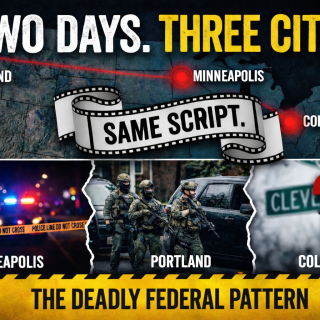I take the unprecedented step in the history of the City of Columbus to voice a demand publicly for an apology and reparations for neighborhood destruction by the City in collusion with large corporate property owners and developers, and in the case of the University District (UD) and Weinland Park, The Ohio State University and its purposely misleadingly named Campus Partners for Urban Community Development.
This is one critical chapter in the long and continuing tragedy of the Columbus Way: private over public, for-profit developers and corporation over publics, and disregard and disrespect for residents’ legal rights including homeowners, taxpayers, and voters. It is no wonder that Columbus cannot define or delineate actual “neighborhoods.”
I am concerned specifically with the University District. But I urge residents of Weinland Park, Franklinton, Linden, and The Hilltop, at least, to follow suit (pun intended).
I demand $1,000,000,000—that is, One Billion Dollars—to be paid by the City of Columbus which granted all but automatic variances against the official City Code; the large corporate landlords and property managers whose very existence violates the City Code; Columbus’ undemocratic and self-interest promoting Area Commissions who make no effort to represent the residents of their areas; and OSU who had more than three-quarters of a century to respond responsibly and in accord with its unmet rhetoric since its founding in 1870 but failed and continues to fail.
I charge all those who colluded in the destruction of one of Columbus’ most attractive and historic areas.
I write often about the University District and also about neighborhoods in general and my home University District in particular. My former student Ellen Manovich wrote the essential history of the area. (See reference below)
Briefly, the UD was a relatively stable, growing but intermixed homeowner, non- or part-time student renter, and student renter residential area through most of its history. One of Columbus’ older, most attractive residential areas, former creeks and now ravines cross it.
Its course is inseparable from OSU’s episodic spurts of growth. It is not well known that OSU students always lived in the UD or that OSU had no on-campus dormitories until after World War II with its rapid expansion fueled by the segregationist GI Bill, just as OSU’s origins lie in the early Civil War racist, sexist, and narrowly vocational Morrill Land Grant Act that appropriated Indigenous Lands for public colleges. (Unlike many other land grant universities, OSU has not apologized publicly.)
Contrary to the unresearched little vanity press anti-histories of the UD, there is no “golden age” of the UD prior to the “invasion” of students. Historically—that is, for the first century of the university’s history—students boarded, rented rooms or space—from homeowners, typically families after their children left home, and quite often with OSU professors and staff who frequently lived in the neighborhood adjacent to their places of work. Or, they lived in small independent rooming houses.
For example, Frambes Avenue, whose western blocks were usurped by OSU in collusion with the City of Columbus for its northward expansion for labs and dorms after the 1970s and 1980s, was occupied almost 100 percent by faculty into the 1980s. All private homes west of North High Street were destroyed. No alternative plans were considered by any of the parties. Other universities and cities reveal the wide range of possibilities. Of course, no university has a perfect record.
The City Code formally sets limits on both the number of dwellings that any one property owner may hold, and the number of unrelated persons who may live under the same roof.
Gradually after the 1960s but accelerating rapidly in the 1980s, 1990s, 2000s, multiple forces descended to damage the historic, homeowner, actually university—that is, faculty, staff, and students--residential area.
The processes of neighborhood change, conversion, transfer, decline, and destruction are both simple and complicated, in fact contradictory. In part, common elements of residential succession--in the language of geographers and sociologists--were dramatically accelerated by the combined actions and inactions of the City of Columbus, large corporate landlords and property managers, and OSU.
For example, as homeowners age, they are more likely to sell their homes and move to retirement centers or other alternatives. More than a few pass away. As children in homeowning families grow up, some families move to other residential areas and to suburbs. In the case of the UD, city actions—in direct contradiction of the letter of the Zoning Code--significantly increased these so-called “natural processes.”
On one hand, City Zoning Inspectors, certainly with the knowledge and approval of supervisors, division heads, mayor’s and city councilors’ offices, almost automatically granted zoning variances to allow the creation of large corporate multiple property owners (most notable are NorthSteppe, HomeTeam, OSUlive, Buckeye, OSUproperties, among others) with far more than 5 unrelated individual living together. Technically speaking, the City itself permitted, even encouraged, the illegal. This, I add, is part of the Columbus Way. The UD is not an exception.
Inseparable from this is the City’s granting permission for a substantial number of small and medium sized 1950s and 1960s-style apartment buildings that are completely inappropriate for a historic neighborhood. We know that Columbus has no authentic and responsible urban planners or design guidelines. A quick glance at downtown Colemanville and the declining Short North shows that. In the UD, these one and two story brick structures blight the urban landscape like an infectious urban disease.
Over decades, the City actively advanced neighborhood decline and destruction. All complaints and appeals from remaining homeowners are ignored. Zoning and Neighborhoods (especially Zoning Enforcement), Public Services, Refuse, Sanitation, and the Police do not inspect or enforce codes, mandate or make repairs to sidewalks and streets, inspect for trash and sanitation, or enforce the law.
“Joint CPD-OSU patrols” and “Buckeye Block Watches” are little more than slogans. The University Area Commission and so-called University District Organization do nothing for their neighbors and only protect themselves in muddling and contradictory undemocratic patterns of inaction and occasional action. The large corporate property owners—technically illegal—receive favored treatment.
On the other hand, as the area’s decline was well underway, the City actively propelled the departure of more homeowners with young children by closing a good public elementary school on Sixteenth Avenue in the middle of the UD. A continuing success of private charter schools does nothing for the area other than contributing to traffic and parking violations. Its sidewalks and driveways, like other others, are broken. Public Service does not care; there are no profit to be made.
My wife and I purchased our historic house in 2004 from a family vacating a house they loved for the sake of their three year old’s schooling. We watched other homeowners, young and old, follow the same path, mainly to the suburbs.
Our own realtor and many at OSU urged us to relocate in Worthington or Upper Arlington. Leaving our Victorian house in a large nationally-designated historic district in San Antonio, we could not ignore the large corner lot with an ancient sycamore tree, space for my too-many books, and room for guests, all within a 10 minute walk from my OSU office.
The people from whom we purchased it transformed it back into single family from the five separate units it had become, against City Code. It was originally designed by a major local architect for a wealthy merchant’s two spinster daughters. It has a history and an identity, in history- and identity-less Columbus.
Not surprisingly, OSU’s Campus Partners—only with private for-profit developers—failed to inform me about their paltry $3000 mortgage assistance, far less than other universities. This is the OSU Way.
For decades, Campus Partners refused almost all opportunities to help stabilize and improve its own University District neighborhood. It contradicts its own empty rhetoric at every step.
Despite repeated requests to purchase for-sale houses either to resell to incoming faculty and staff, and especially to buy them for OSU to create themed residential houses—from faith to pre-professional, social issues, and beyond houses--that are enormously popular at other universities, Campus Partners only works to assist private developers, functioning at a significant loss to the university.
The uncontrolled corporate developers pass money to everyone who might assist them, above, below, and around the proverbial table. But never to aid their tenants or the neighbors who lives they disrupt and sometimes threaten.
This is well known. Sums go to the City in various ways. The very worst of the large landlords (about whom I have written previously) is well known for catering to fraternity members escaping their chapters in order to party more wildly, and cheating, stealing, and lying, He has given more than $5 million to OSU. OSU will not warn students about any of the companies’ criminal “business models” despite class action suits underway and Student Legal Services literally overflowing with student tenants’ complaints. Students have died in some of these rental properties.
OSU’s Office of Student Life, who has little interest in real students’ lives, has promised homeowners for decades to provide students with relevant information on Columbus laws and their own tenants’ rights. It has never done that.
It now has a feature on its website to “help[ing] students make informed decisions through The Ohio State University Off-Campus Housing Network.” But the portal linking interested students—making escaping mandatory two year residence on campus because of conditions in the dormitories—aids landlords far more than student renters. Two of the four worst—by all indicators—remain on the approved list, and there is no warning about any landlord. Nor are students “informed” that none of at lease five landlords who appropriate “OSU” in their names have authorization or any relationship to the university. So much for “informed.”
This typical OSU self-promotion includes the completely misleading and dishonest tagline: “The . . . Network establishes certain criteria for off-campus property owners. Those property owners that [sic] commit to meeting these criteria will be considered in-network.” “Commit to” with no accountability or verification?
Stunningly, The Network reverses itself in the next paragraph: “In-network properties are not endorsed or guaranteed by [OSU] or its network collaborators. Rather, being in-network provides students and their families with the information that these property owners have committed to the criteria required to be part of the …. Network.”\
Where do I find an English translation? Do I need Chatbot or one of the robots that rule the pathways on campus? What language does The Network speak? They are marketing agents for almost all landlords who “commit.”
In response to my holding Student Life and Off-Campus…. accountable, in late winter 2022 after actively seeking my advice as a senior member of the university community and a UD homeowner, they abruptly and illegitimately ceased all cooperation and all communications, refuse to fulfill their formal stated obligations, and refuse to provide me with public documents. Laughably, they attempted to have the Legal Office serve me with a “cease and desist order” because I dared to ask them to keep their promises and do their jobs. I was falsely accused of “interfering with their daily business.” OSU bungled that wholly inappropriate action.
Neither OSU Legal Office or Student Life, nor the City of Columbus Attorney’s Office have any interest in holding landlords and property managers legally accountable. They do not respond to repeated requests and trails of records longer than the football teams’ offensive yardage. Need we ask why?
My former next-door neighbors, to take an example, were forced to sell the house they inhabited for more than forty years because a place in a retirement community became available sooner than anticipated. The local corporate executive who purchased it lied about who would like there. It immediately became a very problematic home to eight tenants mismanaged by one of the largest “slumlords” as they are called by all concerned. The property has been in continuous disrepair with inadequate trash containers. It is one among thousands.
We remaining homeowners are pestered multiple times daily with unsolicited calls and letters offering to “buy your house for cash”—as if any of us would respond to such an offer. I respond by informing these callers, mainly of whom do not speak English, about the existence of the federal no call list on which our phone number sits.
Failure to keep promises, honor commitments, behave responsibly and respectfully, and obey the law unites the City, the landlord and property managers, and OSU. They are all colluding peas in a failing pod.
Is $1,000,000,000 sufficient to compensate all the homeowners past and present, cheated, lied to, denied our rights, limited our material and personal well-being? All those driven out, misled, and under-compensated?
And the decaying physical environment, the filth, and lack of sanitation? And the lack of law enforcement?
And of course, the 100s of 1000s of students lied to, cheated, and ill-served by their landlords “business models” with the collusion of the City and OSU?
Must all the spoils continue to go only to the profiteers, cheaters, liars, and law-breakers, elected and unelected?
I demand reparations for urban destruction in the biggest little city in the US with no history and no identity.
References
Ellen Manovich, “‘Time and Change Will Surely Show’: Contested Urban Development in Ohio
State’s University District, 1920-2015,” Journal of Social History 51 (2018), 1069-1099
Kevin Cox, Boomtown Columbus: Ohio’s Sunbelt City and How Developers Got Their
Way. Columbus: Ohio State University Press, 2021
Harvey J. Graff, “The decline of a once vital neighborhood: Columbus’ University District,” Columbus Free Press, Sept 14, 2021
“Columbus’ University District: Students and the institutions that fail them,” Columbus Free Press, Oct. 8, 2021
“How Columbus, Ohio State University, and major developers destroyed a historic neighborhood,” Busting Myths, Columbus Free Press, Part One, Apr. 26, 2022
“How Columbus, Ohio State University, and major developers destroyed a historic neighborhood,” Busting Myths, Columbus Free Press, Part Two, Apr. 29, 2022
“How Columbus, Ohio State University, and major developers destroyed a historic neighborhood—a continuing saga,” Busting Myths, Columbus Free Press, May 2, 2022
“Franklinton, 1797-2022 and Columbus’ Contradictions, Part 1,” Columbus Free Press, June 5, 2022
“Franklinton, 1797-2022 and Columbus’ Contradictions, Part 2,” Columbus Free Press, June 9, 2022
“The Columbus Way versus the rights of residents, Part One,” Busting Myths, Columbus Free Press, June 21, 2022
“The Columbus Way versus the rights of residents, Part Two, Busting Myths, Columbus Free Press, June 24, 2022
“The Columbus Way versus the rights of residents, Part Three,” Busting Myths, Columbus Free Press, June 27, 2022
“The Columbus Way versus the rights of residents, Part Four,” Busting Myths, Columbus Free Press, June 30, 2022
“How universities fail their students: The president may be “born to be a Buckeye,” but the students are not. A call to eliminate Offices of Student Life and invest directly in students’ lives,” Busting Myths, Columbus Free Press, Nov. 10, 2022
“The City that breaks its laws has a police force that refuses to enforce the city’s laws: The Columbus Way, Part One,” Busting Myths, Columbus Free Press, Nov. 13, 2022
“The City that breaks its laws has a police force that refuses to enforce the city’s laws: The Columbus Way, Part Two,” Busting Myths, Columbus Free Press, Nov. 16. 2022
“Columbus’ anachronistic, private interest-dominated ‘area commissions’ and ‘neighborhood organizations’ must go,” Busting Myths, Columbus Free Press, Dec. 3, 2022
“Columbus’ home grown illegal landlords in a destroyed historic district,” Busting Myths, Columbus Free Press, Dec. 11, 2022
“Universities and cities often fail both homeowners and students,” Times Higher Education, Jan. 22, 2023
“A city versus its neighborhoods: Columbus, Ohio,” Busting Myths, Columbus Free Press, Jan.
25, 2023
“Unsafe at any speed: The unsafe city—from mayor to city council to CPD,” Busting
Myths, Columbus Free Press, Feb. 16, 2023
“J’accuse: The City of Columbus Division of Public (aka Private) Service,” Busting Myths,
Columbus Free Press, Mar 3, 2023
“How can a city with no history destroy its history? The Columbus Way,” Busting Myths,
Columbus Free Press
“Living in a University District: How universities and their cities fail both homeowners and
student renters,” Busting Myths, Columbus Free Press
“Disconnecting Gown and Town: Campus Partners for Urban Community Development, Ohio State University,” forthcoming
------------------------------------------------------------------------------------
Harvey J. Graff is Professor Emeritus of English and History at The Ohio State University and inaugural Ohio Eminent Scholar in Literacy Studies. Author of many books, he writes about a variety of contemporary and historical topics for Times Higher Education, Inside Higher Education, Academe Blog, Washington Monthly, Publishers Weekly, Against the Current; Columbus Free Press, and newspapers. Searching for Literacy: The Social and Intellectual Origins of Literacy Studies was published by Palgrave Macmillan in 2022. My Life with Literacy: The Continuing Education of a Historian. The Intersections of the Personal, the Political, the Academic, and Place is forthcoming.



